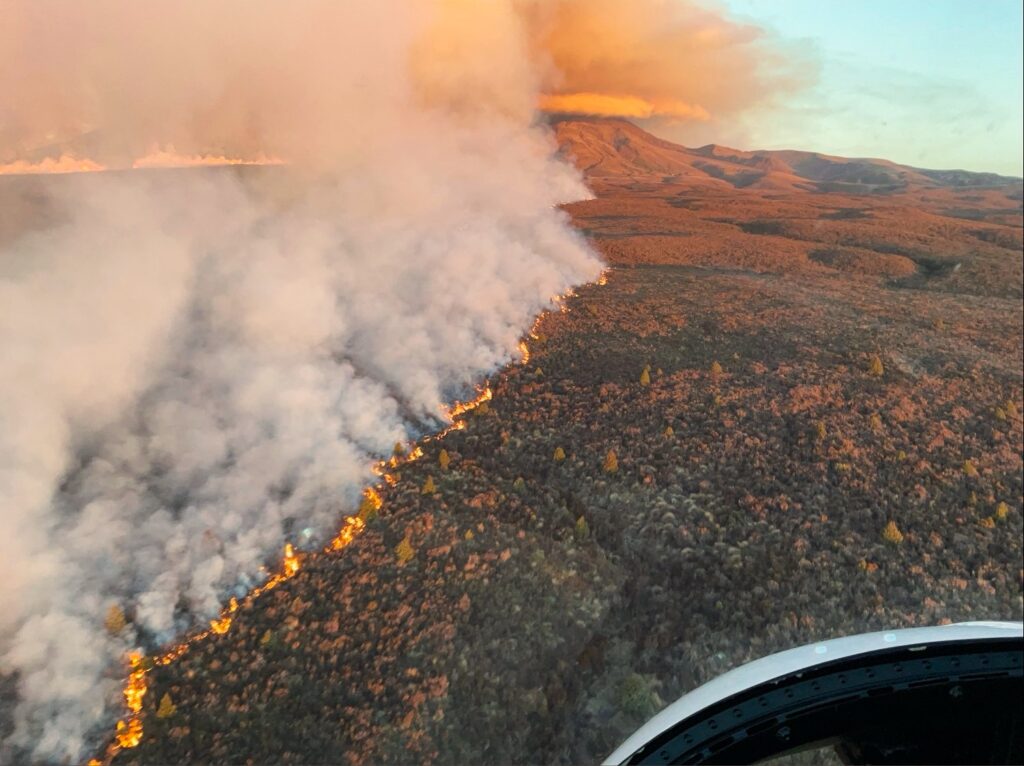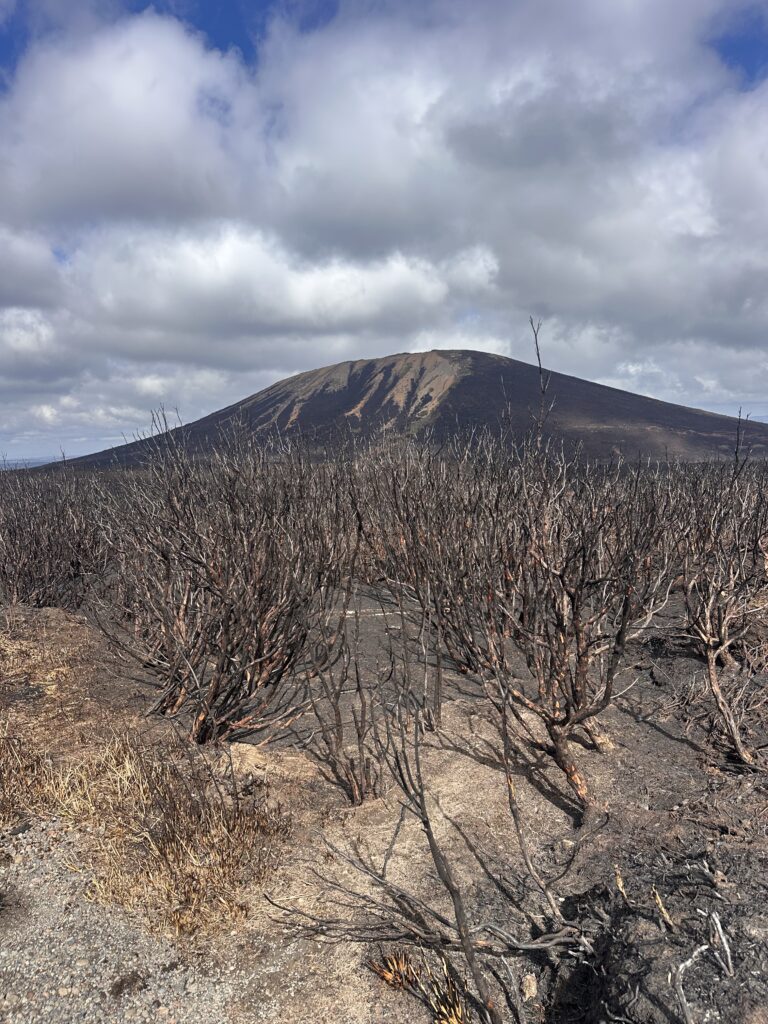
A devastating wildfire has scorched 3000 hectares of Tongariro National Park, but as the community rallies and recovery gets underway, conservation leaders say the blackened landscape could open the door to a rare chance for large-scale native regeneration.
By Moana Ellis, Local Democracy Reporting
A unique ecological legacy could rise from the ashes of the Tongariro National Park wildfire if long-term recovery work succeeds.
Conservation Minister Tama Potaka said eradicating weed and animal pests from the blackened landscape would be “top of mind” to give natural native regeneration the best chance.
The massive blaze tore through 3000 hectares of New Zealand’s oldest national park last week, burning out of control for nearly three days across the Central Plateau. Helicopters, planes and ground crews fought to contain it as flames triggered evacuations of trampers and residents.
Department of Conservation (DOC) Central North Island operations director Damian Coutts described the desperate situation as the fire, which broke out on Saturday, November 8, continued to run.
“It felt bloody awful,” Coutts said.
“Sunday night this thing was not under control and spreading rapidly, even with 21 machines hitting it with everything they had. They couldn’t stop it,” he told a meeting of the Waimarino (National Park Village) community on Monday night.
Civil defence controller, district council chief executive Clive Manley, told residents the fire was one-and-a-half times the size of Wellington, and had ripped through four percent of the national park.
“It was huge in firefighting terms. No lives were lost, few properties were lost. There was a lot of work to protect them and to get people out – a superb effort – but it was a huge, huge drain on the people in our community and [it will have] a lasting impact.”
Monday night’s meeting gathered Ministers, Fire and Emergency NZ, Civil Defence, DOC and local and regional council leaders to brief the community on response and recovery efforts.

The fire swept through sub-alpine and alpine scrub, tussock grassland, wetland and forest habitats for threatened plants and wildlife including insects, kārearea/New Zealand falcon and whio/blue duck.
Rain eventually helped bring the blaze under control. It was officially declared extinguished on Sunday, 16 November.
Coutts said specialists were now assessing the damage.
“We are committed to doing a fire environmental impact assessment first and a restoration framework linked to that assessment,” he said.
“It looks really black out there but the fire went through so fast there isn’t [a thick] ash layer. When firefighters were in there digging up the hotspots, there was green in there. So plants below the ground are still green – they will come back.”
The fire has cleared a vast swathe of land, and with it competition for invasive weeds such as heather, gorse, broom and wilding pine that can take hold rapidly after disturbance.
Replanting was unlikely, Coutts said. Natural regeneration would recover the area if weed and animal pests were kept in check.
“It will re-shoot quite quickly. There’s a risk that we’ll see hares, rabbits, deer coming in and browsing on the new growth, so there’s going to have to be both an animal and a weed pest control programme.
“The opportunity here is to build a bigger programme of biodiversity inside Tongariro National Park and to go after broom, gorse and some of its friends on a broader scale.”

DOC Tongariro operations manager Libby O’Brien said the blaze was among the largest fires ever seen in Aotearoa on conservation land.
“Even the tiniest fire is a massive scar on that landscape, but from any vantage point within the national park, so much of what you can see is black.
“It’s whenua that is ridiculously important and special to anyone that’s ever been there, whether you whakapapa to that land, whether you live here, or whether you’ve visited.”
Established in 1887 and spanning 79,000 hectares, Tongariro was New Zealand’s first national park and the fourth in the world. Its three active volcanoes and cultural and geological significance make it a UNESCO dual World Heritage site.
A week-long rāhui placed by local iwi on the Tongariro Alpine Crossing and surrounding area was lifted early Monday, the day after the fire was extinguished. A second, decade-long restorative rāhui was placed over the burn area by Ngāti Hikairo ki Tongariro, a hapū of Ngāti Tūwharetoa, to protect the whenua as it heals.
O’Brien said the park was “relatively lucky” from a recreation viewpoint. Damage to the Tongariro Alpine Crossing carpark would limit use for several weeks, while the Mangatepopo Track – part of the Tongariro Northern Circuit Great Walk – would be closed for at least the season as DOC plans for a replacement hut and track upgrades.
It was still too early to fully understand the ecological toll.
“We’ve only just been able to get people out there to assess the issues,” O’Brien said.
“We know we’ve lost a lot of biodiversity. Wildlife – there will be a lot missing. There are a lot of birds up there flying around – birds of prey having a look – and I’ve seen more hares than I’ve ever seen up there. It will be interesting to see how that ecosystem shifts or evolves as regeneration occurs.”
She said the fire had been devastating and traumatic but had united the community behind recovery.
“The silver lining is we’ve got this amazing opportunity to stop those weeds from coming back, and to keep out browsing animals that move seeds around.”
The challenge ahead would be securing and coordinating a long-term restoration workforce.
“We could always do more if we had more people. The trick’s going to be working with the willing – volunteers, partner agencies, hapū and iwi … so many people are keen to help.”
The cause of the wildfire remains under investigation.
Awa FM – Te Reo Irirangi o Whanganui
For more of our people, our stories, our way, click News or follow us on Facebook.
